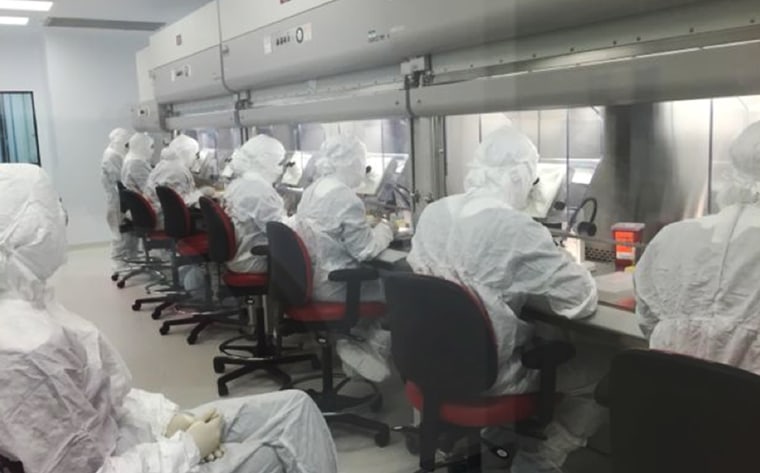An experimental malaria vaccine appears to protect half of the people who tried it for as long as a year — an effect greater than the only licensed vaccine now available, researchers said Monday.
It’s the first big success for a tiny company that’s been working out of a Maryland strip mall for a decade, and offers some real hope to fighting an infection that kills half a million people a year, most of them children.
The company, called Sanaria, makes the vaccine using the entire Plasmodium falciparum parasite. The vaccine protected 55 percent of volunteers from infection, and it stopped the parasite from circulating in their blood so that they could not infect anyone else, either.

“It is potentially a really very impressive vaccine,” said Dr. Tony Fauci, head of the National Institute for Allergy and Infectious Diseases, which helped test the vaccine.
The Phase I clinical study was only the first stage of testing the vaccine, and involved just a few volunteers. The vaccine is years away from the market still.
But 55 percent protection looks better than the 30 percent protection offered by drug giant GlaxoSmithKline’s vaccine Mosquirix, which won approval from European drug authorities last year.
Malaria is carried by mosquitoes, and the parasite can persist in the human body for years. It's harder to make a vaccine against a parasite than a virus or bacteria, because the parasite has a complicated life cycle that takes it from the blood to the liver and back again.
Malaria’s such a problem that health officials and governments are desperate to try anything that will help. Insecticides, bed nets and draining wet breeding ground can help, but nothing’s conquered the infection.
“It is potentially a really very impressive vaccine."
Glaxo’s vaccine uses a traditional vaccine approach — a piece of the protein from the Plasmodium parasites, made into an injection.
Sanaria takes a different approach. The company removes the entire immature Plasmodium— a little organism called a sporozite — from infected mosquitoes. These are weakened using radiation and then made into a vaccine.
It’s been very difficult to get good immunity in real life, but Sanaria CEO Dr. Stephen Hoffman says an intravenous infusion of the stuff seems to be doing the trick.
“Our goal is a vaccine that can be used to immunize the entire population to halt transmission and eliminate the parasite. That’s a rather lofty goal,” Hoffman told NBC News.
“Another goal is to able to use the vaccine to prevent malaria in travelers, diplomats, expatriate workers, military personnel; people going in and out of malaria-affected zones.”
Medication can help prevent infection, but it’s clumsy to use and has some serious side-effects.
For the trial, a team at NIAID and the University of Maryland immunized 57 healthy people who’d never had malaria, and compared them to 32 unvaccinated volunteers. Everyone agreed to be bitten by malaria-infected mosquitoes three weeks later.
Related: Malaria Cases Hit 40-Year-High in US
The effects varied depending on how many doses people got. Only two out of nine of those who got four doses of the vaccine became infected with malaria, compared to five out of six unvaccinated volunteers, the team reported in the journal Nature Medicine.
That works out to 73 percent efficacy.
The team tested different groups over time to see how long the protection lasted. The volunteers were bitten several times over several weeks by malarial mosquitoes.
There were five volunteers who got four doses who never became infected. They got one last visit with the mosquitoes 13 months after they were immunized. None of them became infected.
Overall, the protection works out to 55 percent, the researchers said. The company will now tweak the dosage and the way they administer the vaccine to see what will work best.
“This not only prevents individuals from getting sick, but it prevents them from getting parasites in their blood.”
There were few side-effects, the researchers found.
Fauci said blood tests of the volunteers showed the vaccine was working well.
“Other malaria vaccines may prevent you from getting sick from malaria,” Fauci told NBC News. “This not only prevents individuals from getting sick, but it prevents them from getting parasites in their blood.”
If enough people were vaccinated and if the vaccine protected them all in the same way, “that would eliminate malaria,” Fauci said.
Hoffman said the company has embarked on a series of studies in Tanzania, Kanya, Mali, Burkina Faso and other countries where malaria is a problem. They’ll be vaccinating babies, children and adults.
“We are not stopping until we get to a defined level of protective efficacy,” Hoffman said.
“We want to get on the market with the world’s first U.S. Food and Drug Administration and European Medicines Agency licensed vaccine.” Glaxo’s vaccine is not FDA-approved.
Related: Drug-Resistant Malaria is a Disaster in the Making
Fauci says the intravenous administration is not the easiest way to deliver a vaccine. Intravenous administration is a little slower and the person giving the vaccine has to slowly infuse it into a vein.
Hoffman disagrees. “Tens of millions of people have their blood drawn every day,” he said. The IV administration — different from a simple injection into the muscle or under the skin — uses a smaller needle than those blood draws and only take a few seconds.
He says it causes fewer side-effects, such as painful lumps, because the vaccine liquid isn’t sitting as a lump under the skin, but dispersing quickly into the bloodstream. He says the vaccine can be delivered in vacuum flasks cooled using liquid nitrogen, making them portable and easy to distribute in regions where electricity and refrigeration are scarce.
And Sanaria has solicited an unusual method of funding. When some big investors abandoned his company after a few disappointing results, he went straight to the governments of countries most affected by malaria. They’re helping fund its development.
“This is an extraordinary change,” Hoffman said. “They want a malaria vaccine that works.”

